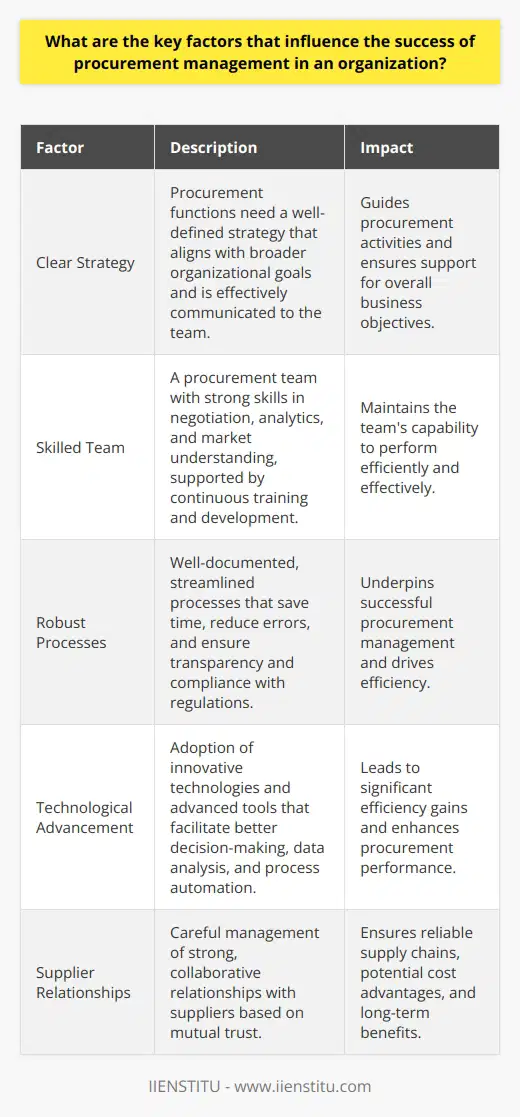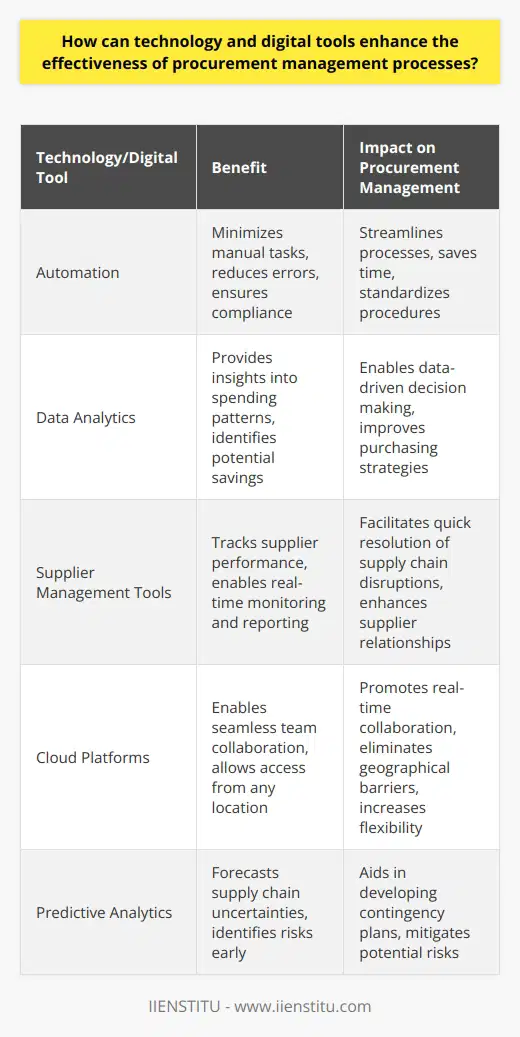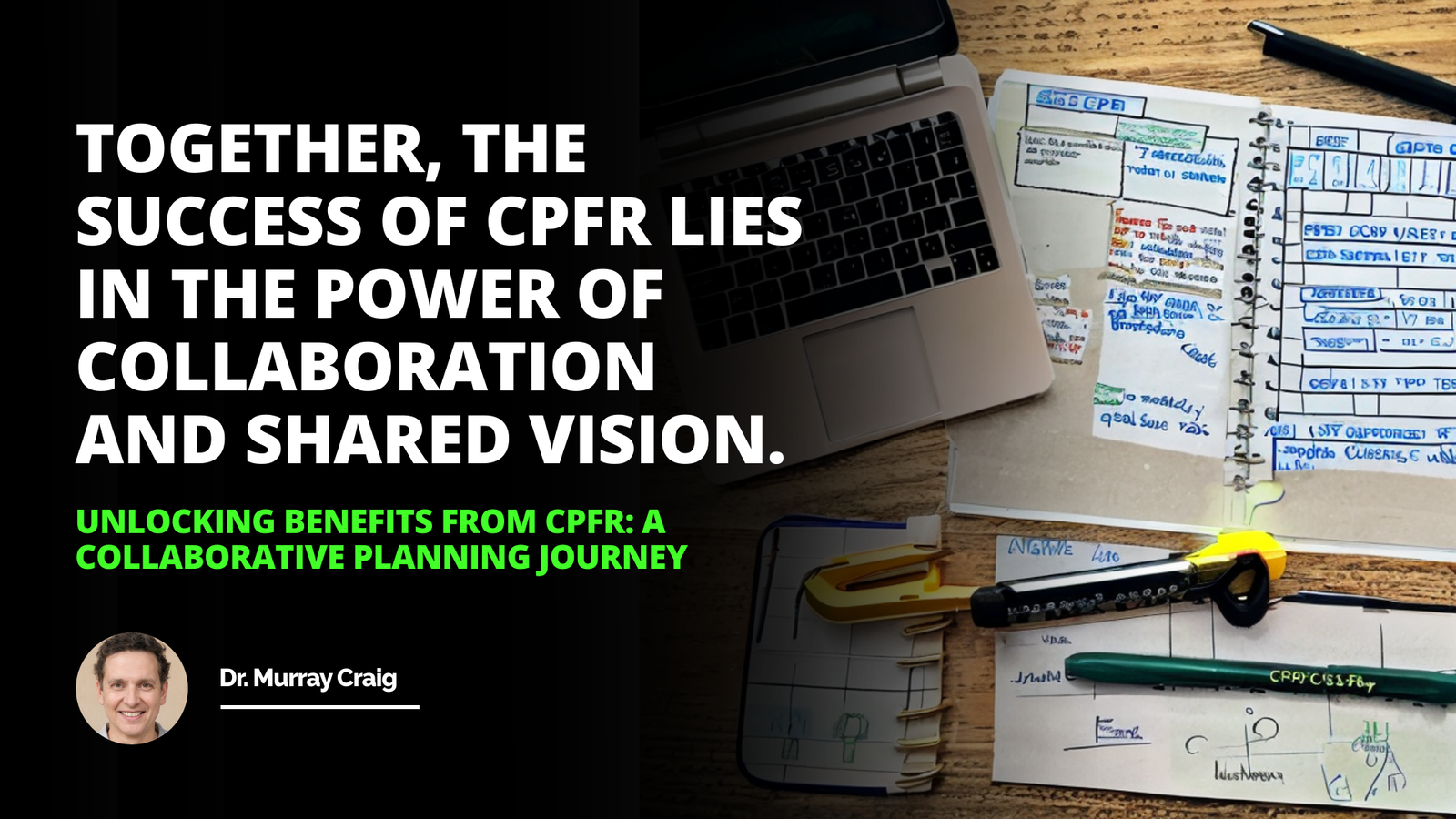
The realm of procurement management serves as a cornerstone of successful operations in businesses across various industries. It is an integral process that involves sourcing and acquiring goods and services that are critical to an organization's operations.
Effective procurement management not only ensures a streamlined process of acquiring these goods and services but also contributes to cost savings, improves organizational efficiency, and enhances supplier relationships. As such, possessing a comprehensive understanding of procurement strategies is vital to achieve optimal results in this multifaceted business function.
Understanding the Procurement Management Process
Supplier Identification: Identifying potential suppliers is the first step in the procurement management process. This initial phase sets the stage for an organization's sourcing strategy. The identification process involves thorough market research, analyzing industry trends, and considering supplier capabilities. It is essential for procurement teams to comprehensively assess potential suppliers against the company’s requirements, including evaluating the suppliers' track record, financial stability, and capability to fulfill demands. The success of this phase profoundly impacts the subsequent steps, as it narrows down the number of potential suppliers to those most compatible with the organization's goals and needs.
Supplier Evaluation and Selection: Once a roster of potential suppliers is compiled, the rigorous task of evaluation and selection begins. This involves criteria that may include cost effectiveness, quality assurance, reliability, and adherence to regulatory standards. The evaluation process also entails vetting suppliers’ reputation and performance metrics. Selecting the right suppliers is a critical decision; it necessitates a delicate balance between quality and cost, ensuring organizational objectives are met while fostering positive, long-term relationships with suppliers.
Contract Negotiation: Contract negotiation is a pivotal stage in procurement management; well-negotiated contracts are the backbone of favorable procurement outcomes. Effective contract negotiation involves detailed discussions on pricing, delivery schedules, quality standards, and terms and conditions that govern the partnership. This phase also requires a keen understanding of both legal implications and business practicalities. Proper negotiation strategies protect the organization's interests while simultaneously laying the groundwork for cooperative supplier relationships.
Supplier Relationship Management
Maintaining healthy and productive relationships with suppliers is an imperative part of procurement management. It involves continuous interaction, performance reviews, and conflict resolution mechanisms.
Supplier relationship management (SRM) emphasizes collaboration, trust, and mutual benefit, which can lead to improved service levels, innovation, and preferable pricing. Effective SRM is a testament to an organization's strategic foresight in nurturing partnerships that yield long-term dividends.
Procurement Risk Management
Explanation and Importance: A robust procurement process must manage risks proactively. Procurement risk management addresses potential pitfalls and disruptions that could impair the supply chain or impact the business financially. It is a comprehensive approach that includes identifying, assessing, managing, and monitoring risks. Its importance cannot be overstated as unexpected events such as market volatility, geopolitical instability, or supplier bankruptcy can jeopardize the procurement process.
Strategies to Mitigate Procurement Risks: To effectively mitigate risks, companies are encouraged to diversify their supplier base, implement stringent quality control measures, maintain a buffer stock, and keep abreast of market conditions and trends. Risk mitigation plans must be dynamic, constantly evolving with the changing risk landscape. A multidimensional risk strategy can safeguard against disruptions, enabling an organization to pivot swiftly and efficiently when challenges arise.
Roles and Responsibilities in Procurement Management
Role of Procurement Manager
Description: The procurement manager is the linchpin of the procurement department, bearing the responsibility for overseeing the procurement process from inception to completion. This role calls for a strategic thinker and an effective leader who can manage teams, develop procurement strategies, and interface with suppliers and internal stakeholders. A procurement manager must also possess proficiency in areas of finance, supply chain management, and contract law.
Key Functions: Their key functions encompass sourcing strategy formulation, process improvement, cost reduction initiatives, and compliance maintenance with legal and company standards. The procurement manager plays a crucial role in strengthening supplier relationships and ensuring the reliability and quality of the procurement process. Their expertise is essential in navigating the nuances of the procurement landscape, including leveraging logistics management courses and certifications to enhance their skills and knowledge.
Role of Procurement Team
Description: The procurement team is an ensemble of professionals with varied expertise within the procurement process. A cohesive team is instrumental in executing the strategic vision laid out by the procurement manager. Each member plays a vital role, contributing to different segments of the process such as research, negotiations, and contract management.
Key Functions: Their collective key functions involve supplier engagement, data analysis, negotiation support, and administrative tasks necessary to facilitate procurement activities. The team ensures execution alignment with strategic objectives and serves as the operational arm of procurement management. Adequately trained through relevant certificate courses online, the procurement team can apply best practices and contemporary knowledge to their roles, bringing value and innovation to the procurement function.
Technologies in Procurement Management
Utilization of Digital Tools
Explanation of Digital Procurement Systems: Advancements in technology have led to the integration of digital tools in procurement management, streamlining and automating the end-to-end process. Digital procurement systems offer real-time analytics, electronic documentation flow, and an interface for supplier collaboration. These systems reduce manual errors, promote efficiency, and provide analytical insights for better decision-making.
Advantages of Implementing Digital Tools: Implementing digital tools in procurement processes engenders transparency, enhances strategic sourcing, and propels cost savings. Integrating e-procurement software creates a centralized system, making it easier to monitor expenditures, manage contracts, and optimize inventory. The strategic deployment of digital solutions is pivotal in maintaining a competitive edge in the rapidly changing procurement arena.
Role of AI in Procurement Management
Benefits of AI in Procurement: Artificial Intelligence (AI) in procurement ushers in a new era of automation and intelligence. It offers remarkable feats such as predictive analytics, enhanced data processing, and smarter decision-making capabilities. AI can streamline repetitive tasks, extract actionable insights from large data sets, and aid in sophisticated risk assessment.
Case Study or Examples of AI in Procurement: In practical applications, AI has been used to predict supply chain disruptions, automate supplier negotiations, and personalize purchasing experiences. For example, a global manufacturer implemented AI to optimize their supplier selection process, resulting in reduced procurement cycle times and significant cost savings. The use of AI in procurement is an emerging trend with the potential to transform traditional procurement paradigms.
Best Practices in Procurement Management
Effective procurement management hinges on a suite of best practices that are critical for organizational success. These practices revolve around strategic sourcing, efficient communication, and performance evaluation. By adhering to these best practices, organizations can drive value, foster ethical procurement, and remain adaptable in a dynamic business environment.
Importance of Strategic Sourcing and Vendor Management: Strategic sourcing is essential for identifying the best suppliers and negotiating favorable terms. It requires a comprehensive approach that incorporates market analysis, total cost of ownership, and supplier performance metrics. Combined with effective vendor management, which focuses on developing strong relationships and ensuring mutual success, strategic sourcing can significantly contribute to achieving a cost-effective and reliable supply base.
Value of Effective Communication in the Procurement Process: Effective communication is the linchpin of procurement management, ensuring that all parties have a clear understanding of expectations, timelines, and responsibilities. This includes internal communications with stakeholders to ascertain needs and external communications with suppliers to maintain healthy relationships. Open, timely, and accurate communication minimizes misunderstandings and builds trust—a crucial element in any procurement relationship.
Necessity of Regular Performance Tracking and Evaluation: Keeping a tab on performance metrics is fundamental for continuous improvement in procurement management. Regular tracking and evaluation of supplier performance, compliance with contracts, and efficacy of procurement strategies provide data-driven insights that can inform future decision-making. Continuous improvement methodologies like Six Sigma can be used to identify areas of waste and inefficiency, driving progress and refinement in procurement practices.
Current Trends and Future Projections in Procurement Management
As the procurement landscape evolves, it is shaped by an array of trends and innovations that signify the future direction of the industry.
Emergence of Sustainable Procurement
Sustainability has become a central theme in procurement practices, with organizations increasingly recognizing the importance of environmental and social responsibility in their sourcing decisions. Sustainable procurement takes into account the long-term impact of procurement activities and prioritizes suppliers who adhere to ethical, environmentally friendly practices.
Increased Emphasis on Ethical Sourcing
Ethical sourcing is gaining prominence as consumers and businesses alike demand transparency and morality in the supply chain. This trend is driving organizations to meticulously review their supplier's labor practices, environmental impact, and overall governance to align with corporate social responsibility goals.
Future Projections based on Current Technological Advancements
Technological advancements such as blockchain, the Internet of Things (IoT), and advanced analytics are setting the stage for the next wave of innovation in procurement. These technologies are anticipated to offer unprecedented levels of transparency, efficiency, and intelligence, shaping the future of procurement management to be more connected, ethical, and sustainable.
Throughout this discourse, we have delved into the multifaceted domain of procurement management. From supplier identification to risk management, and embracing cutting-edge technologies, we have charted a course through the essential elements that define effective procurement strategies. We have underscored the crucial roles and contributions of procurement managers and their teams, highlighted best practices, and looked ahead at emerging trends that promise to recalibrate the procurement landscape. It is evident that procurement management remains a strategic imperative for organizations seeking to thrive in the competitive global marketplace. As we conclude, it is imperative to reiterate the ongoing need for agility, foresight, and innovation in procurement management, integral components for sustained organizational success.
Frequently Asked Questions
What are the key factors that influence the success of procurement management in an organization?
Key Factors Influencing Procurement Success
Clear Strategy
Procurement functions need a clear strategy. Such a strategy aligns with broader organizational goals. Managers must understand this strategy well. They must also communicate it effectively. The strategy guides procurement activities. It ensures that procurement supports overall business objectives.
Skilled Team
The importance of a skilled procurement team is paramount. Team members must possess the necessary skills. These include negotiation, analytics, and market understanding. Continuous training and development are essential. They maintain the team's capability to perform efficiently.
Robust Processes
Efficient processes underpin successful procurement management. They must be well-defined and documented. Streamlined processes save time and reduce errors. They also ensure transparency and compliance with regulations.
Technological Advancement
Technology greatly impacts procurement. Advanced tools facilitate better decision-making. They enable data analysis and process automation. Adopting innovative technologies can lead to significant efficiency gains.
Supplier Relationships
Strong supplier relationships are crucial. They ensure reliable supply chains and possible cost advantages. Mutual trust and collaboration with suppliers can result in long-term benefits. It is important to manage these relationships carefully.
Risk Management
Risk management is critical in procurement. Managers must identify potential risks early. They should also develop mitigation strategies. This proactive approach can prevent disruptions and maintain supply chain integrity.
Performance Measurement
Key performance indicators (KPIs) are necessary for measuring success. They must be relevant and aligned with the organization's goals. Regular performance reviews using these KPIs can drive continuous improvement.
Compliance and Ethics
Adherence to compliance and ethical standards is non-negotiable. Organizations must follow laws and regulations. They must also uphold high ethical standards. This protects the organization's reputation and avoids legal consequences.
Sustainable Practices
Sustainability in procurement is increasingly important. Organizations must consider environmental and social factors. This includes sourcing from responsible suppliers and reducing waste. Sustainable practices can lead to cost savings and improve brand image.
Flexibility and Adaptability
The procurement landscape is constantly changing. Flexibility and adaptability are therefore necessary. Organizations must be ready to adjust strategies as market conditions evolve. This agility can provide competitive advantage.
By focusing on these factors, organizations can optimize their procurement management. This optimization contributes to achieving strategic goals. It also ensures long-term success.

How can technology and digital tools enhance the effectiveness of procurement management processes?
Technology and digital tools stand at the forefront of transforming procurement management. They offer unprecedented capabilities. These tools streamline and optimize procurement processes.
The Digital Advantage in Procurement
Efficiency Through Automation
One cannot overstate automation's role in procurement. It minimizes manual tasks. This results in significant time savings. It also reduces the likelihood of human errors. Automation ensures compliance with procurement policies. It does so by mandating standardized procedures.
Enhanced Analytical Insights
Data analytics is a game-changing facet. It provides deep insights into spending patterns. It also identifies potential savings. Procurement teams can make data-driven decisions. Such decisions improve purchasing strategies.
Improved Supplier Management
Supplier management becomes easier. Digital tools can track supplier performance. Real-time monitoring and reporting are possible. Teams can quickly address supply chain disruptions.
Streamlined Procurement Cycles
Digital tools speed up the entire procurement cycle. Electronic requests, quotations, and purchase orders facilitate quicker transactions. Approvals need not stall for lack of physical presence. E-signatures serve well here.
Cloud-Based Collaboration
Cloud platforms enable seamless team collaboration. Geographical barriers become irrelevant. Stakeholders access information from any location. They work together in real-time. This flexibility is crucial.
Risk Mitigation
Digital procurement helps identify risks early. Predictive analytics can forecast supply chain uncertainties. Procurement managers can devise contingency plans accordingly.
Environmental Impact
Digital procurement promotes sustainability. It reduces the need for paper. Processes become less resource-intensive. They leave a smaller carbon footprint.
Scalability and Flexibility
Digital tools are highly scalable. They adjust to the organization's growing needs. Flexibility is another key benefit. Procurement systems integrate with other business systems. This ensures a unified approach to management.
In summary, technology fuels procurement excellence. Digital tools offer efficiency and enhanced analytical insights. They aid in improved supplier management. They streamline procurement cycles. Cloud-based collaboration expands team dynamics. These advancements mitigate risk and promote sustainability. They scale with organizational growth. The digital age positions procurement management as strategic and data-centric. Technology is not just an enabler. It is a driver of procurement transformation.

What are some contemporary approaches to risk management in procurement, and how do they contribute to overall operational efficiency?
Understanding Contemporary Risk Management in Procurement
Risk management remains crucial in procurement. It helps secure supply chains. It ensures value in purchasing. Modern strategies focus on operational efficiency. They enhance decision-making and resource allocation.
Tech-Forward Risk Assessment
Automation is pivotal. It reduces human error. Automation speeds risk identification. It also enhances risk monitoring. Data analytics is a cornerstone here. It derives insights from large data volumes. These insights guide proactive risk mitigation. The result is often a more resilient supply chain.
Predictive analysis plays a role too. It forecasts potential disruptions. It relies on historical data trends. Machine learning algorithms improve forecasts over time. They adapt to new patterns. This adaptation strengthens procurement strategies. It reduces surprises and costly last-minute changes.
Supplier Relationship Management
Strong supplier partnerships are essential. They enable better communication. They also foster trust and collaboration. Enhanced collaboration leads to shared risk management. Shared risk management often yields better outcomes. It provides solutions that benefit all parties.
Diversification is another key approach. Sourcing from multiple suppliers spreads risk. It prevents overreliance on a single source. It minimizes impact from a supplier's failure. This diversification keeps operations smooth. It often ensures a steady supply chain, even in crises.
Agile Procurement Strategies
Agility in procurement matters. Agile approaches adapt quickly to change. They do this while maintaining control and visibility. Real-time data informs these agile strategies. Data provides the needed flexibility in decision-making.
Flexible contracts feature here. They accommodate changes without severe penalties. Contracts may include clauses for unforeseen events. These clauses help parties navigate disruptions together. They safeguard operational continuity. They thus contribute to better risk management.
Focus on Compliance and Ethics
Regulatory compliance is non-negotiable. It mitigates legal and financial risks. Strong ethics policies are similarly crucial. They prevent corruption and promote fair practices. Both compliance and ethics safeguard reputation. They protect against legal actions that disrupt operations.
Training programs ensure compliance and ethics. Training instills the right values in staff. It also keeps them updated on legal standards. Well-trained teams better prevent and manage risks. They thus contribute to more efficient procurement processes.
In sum, contemporary procurement strategies offer robust risk management. They support operational efficiency. They guide organizations through uncertainty. They provide frameworks for resilience. Thus, they are indispensable for modern supply chains.



